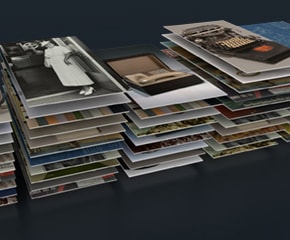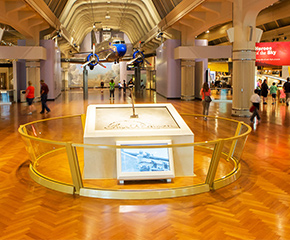
Henry Ford
25 artifacts in this set
Ford Model N Chassis in Assembly Room at the Piquette Avenue Plant, 1906
Photographic print
In 1906 Ford Model Ns were assembled on the third floor of Ford Motor Company's Piquette Avenue factory in Detroit. Cars were put together by crews moving from vehicle to vehicle. No one had yet conceived of the moving assembly line. Behind the rows of cars are engines, stored on their noses to conserve space.
1904 Ford Sales Catalog, "The Blue Ribbon Car"
Trade catalog
This 1904 Ford Motor Company sales catalog shows the choices of "blue ribbon" vehicles offered by Ford. Henry Ford set out to create a lightweight and inexpensive vehicle. He continued to improve on these early attempts. Four years later Ford created the vehicle that he envisioned, the Model T.
Young Henry Ford, circa 1876, with Waterwheel, by Irving R. Bacon, 1935
Oil painting (Visual work)
Henry Ford had his favorite artist Irving Bacon paint several scenes Henry remembered from his childhood. This painting depicts a dam and a waterwheel Henry and a group of friends installed in a small stream. Behind them is the Miller School building, which a grown up Henry had replicated at Greenfield Village.
Sales Brochure, "The Story of the New Ford Car," Ford Motor Company, 1928
Trade catalog
In 1928 Ford Motor Company replaced its aging Model T with a new car called the Model A. Ford literature emphasized the pleasing new styling, the fashionable colors, and the comfortable interiors. The Model A was a good car and sold well, but it was not a game changer like the Model T had been.
Letter from Henry Ford to Milton Bryant Concerning Auto Racing, 1902
Letter (Correspondence)
Less than three months after defeating Alexander Winton, Henry Ford was anxious to stay in the forefront of American racing. In this letter, he explains to his brother-in-law, Milton Bryant, the potential for big money and advertising in match races and his desire to run a race against Henri Fournier, one of the world's fastest drivers at the time. Ford's interest in racing, however, soon put him at odds with the investors of the Henry Ford...
Henry Ford and Edsel Ford in the Fifteen Millionth Ford Car at the Highland Park Plant, 1927
Photographic print
On May 26, 1927, when Edsel Ford drove the last Model T off the line at the Highland Park Plant, his father's face betrayed conflicting emotions. Henry's Model T had changed the world, but its day was over. How did he follow a legend? Some two months later Ford summed up his challenge, "Sixty-four today and the biggest job of my life ahead."
Blackboard Drawing of an X-Engine, 1925
Photographic print
Blackboards were one of Henry Ford's favorite tools when developing a new design. He used them at least as far back as 1907 when work began on the new Model T. Chalk sketches and drawings could be changed quickly as ideas were discussed. Henry was not much of a draftsman, but he surrounded himself with people who could draw.
Advertising Brochure and Poster, "The New Ford V-8 Cylinder Car," 1932
Trade catalog
Other automobile companies had used V-8 cylinder engines for their heavy, expensive vehicles. But Henry Ford wanted a V-8 engine light enough and cheap enough to power an inexpensive car like a Ford. After years of work, the engine was introduced in 1932. This brochure promoted Ford's affordable automobile with its innovative engine.
Henry and Clara Ford in 1896 with Quadricycle, by Norman Rockwell, 1951-1952
Oil painting (Visual work)
In this painting Norman Rockwell gives us an idealized view of Henry Ford building his first automobile in 1896. In a small brick shed behind the Fords' rented home on Bagley Avenue in Detroit, Henry fine tunes a part of the car while his wife Clara looks on, darning socks. The reality was somewhat different. Henry built the little car with the aid of several friends, and much of the work was done in a shop near Ford's place of work, an...
Detroit Automobile Company Delivery Truck outside Factory, 1899-1900
Photographic print
If the name Detroit Automobile Company does not sound familiar it is because the company lasted no more than eighteen months. It was Henry Ford's first effort at building a motor vehicle and it was not successful. Here the company's first product, a delivery truck, parked in front of the factory on Cass Avenue in Detroit. Despite a glowing description in the Detroit News-Tribune, the truck was apparently not a very good vehicle and...
Crowd of Applicants outside Highland Park Plant after Five Dollar Day Announcement, January 1914
Photographic print
Ford workers disliked the new assembly line methods so much that by late 1913, labor turnover was 380 percent. The company's announcement to pay five dollars for an eight-hour day compared to the previous rate of $2.34 for a nine-hour day made many workers willing to submit to the relentless discipline of the line in return for such high wages.
Ford Motor Company, Mack Avenue, Detroit, Michigan, circa 1904
Photographic print
Henry Ford's third automobile company, formed in 1903, set up shop in a former wagon factory on Detroit's Mack Avenue. Ford's small crew assembled Model As from components made elsewhere. As sales increased, the original building was enlarged to two stories. By 1905, Ford Motor Company had moved to a larger facility on Piquette Avenue.
Port Huron Steam Traction Engine Pulling Dump Wagons, circa 1895
Photographic print
Henry Ford kept this photograph in a picture frame where he could see it daily. It reminded him of a pivotal moment in his youth. In July 1876, he had his first encounter with a similar steam traction engine. He never forgot the revelation of what could be done by a machine moving over the road under its own power.
Ford Motor Company Checkbook, 1903
Checkbook
Ford Motor Company's first checkbook, kept by Secretary James Couzens, shows the struggling company's transition. The bank account started with $14,500 on June 26, 1903. It sank to $223.65 by July 10 after 60 checks. Then on July 15, Ford sold its first car for $850. From then on, the balance kept increasing and the company was off and running.
Henry Ford Riding in 1906 Ford Model N Car Outside the Piquette Avenue Plant, circa 1906
Photographic print
For Henry Ford, this Model N represented his ideal of "raising the automobile out of the list of luxuries, and bringing it to the point where the average American citizen may own and enjoy his automobile." A forerunner to the Model T, it proved to be a strong seller from 1906 to 1908.
Advertisement for Ford Motor Company, "1st to 'Grow' Automobile Parts on the Farm," 1946
Advertisement
Featuring company founder Henry Ford, this national advertising campaign includes views that he promoted beginning in early 1928: "Transforming Crops into Motor Car Materials, to Benefit Car Owner and Farmer Alike." In 1931, Henry Ford decided to experiment with soybeans, and by 1933 produced oil for paints and molded ground meal into small plastic car parts, like gear shift knobs.
Attaching Gas Tank to Chassis, Ford Motor Company Highland Park Plant, circa 1914
Photographic print
On the chassis assembly lines, frames, axles, gas tanks, engines, dashboards, wheels, radiators, and bodies came together in that order to produce finished, running automobiles. Workers install gas tanks sliding down from the overhead platform to the assembly line. Tanks contain a gallon of gas so that the Model T cars could be started at the end of the line.
Ford Model T Assembly Line at the Highland Park Plant, 1915
Photographic print
On the chassis assembly lines, frames, axles, gas tanks, engines, dashboards, wheels, radiators, and bodies came together in that order to produce finished, running automobiles. In this view of installing the assembled dashboards, workers connect ignition wires, spark controls, and throttle controls to the engine, and connect the steering column to the tie rods on the front axle.
Henry and Clara Ford in 1893 with Kitchen Sink Gasoline Engine
Oil painting (Visual work)
This painting shows Clara Ford acting as her husband's assistant during an early experiment with Henry's first gasoline engine. It happened at the kitchen sink of their home on Bagley Avenue in Detroit, on Christmas Eve 1893. The artist, Irving Bacon, made this painting in 1938 based on Henry Ford's verbal reminiscence about this pivotal career event.
1903 Ford Model A Runabout
Automobile
After his first two attempts at commercial automobile manufacturing failed, Henry Ford found success with Ford Motor Company, established in 1903. The new company's first product, the Model A, was conventional by the standards of the day. It featured a two-cylinder engine mounted under the seat and rear wheels driven by a chain.
1905 Ford Model B Touring Car
Automobile
The Model B was Ford's first four-cylinder car and the first to have the engine mounted up front in the European manner. Design difficulties delayed production of the Model B and, although conceived much earlier, it went on the market long after the two-cylinder Model C. Priced at $2,000, the Model B was the most expensive Ford yet, and sold poorly.
1908 Ford Model S Roadster
Automobile
The Ford Model S was a composite of the Models N and R. The Model R had used the engine and chassis of the hot-selling Model N, but added running boards, a wider body, and larger wheels. When Ford ran out of Model R bodies and wheels the company put the new running boards on the Model N and called it the Model S.
1930 Ford Model A Touring Car
Automobile
The Model A's two-year-old styling was refreshed for 1930 with new sweeping fenders, a new radiator, smaller wheels, and a longer hood. Ford sold nearly 1,160,000 Model As in 1930, but only 16,470 were open phaetons like this car. Most buyers preferred closed sedans or coupes, with permanent roofs and roll-up windows.
1914 Ford Model T Touring Car, Given to John Burroughs by Henry Ford
Automobile
This 1914 touring car is one of several Model T automobiles given to naturalist John Burroughs by his friend Henry Ford. Ford Motor Company experienced a milestone year in 1914. The automaker fully implemented the moving assembly line at its Highland Park plant, and it introduced the Five Dollar Day profit-sharing plan for its employees.
1932 Ford V-8 Cabriolet
Automobile
The 1932 Ford automobile combines the attractive facelift of the 1931 Model A with the world's first low-priced, cast-in-one-piece V-8 engine. Powered by Henry Ford's latest personal engineering triumph, his "en block", or one piece, V-8 engine, the 1932 Ford outperformed all other popular competitors. The vehicle's improved proportions and styling reflected Edsel Ford's, Henry's son, genius for design.
This is user-generated content and does not reflect the views of The Henry Ford.


